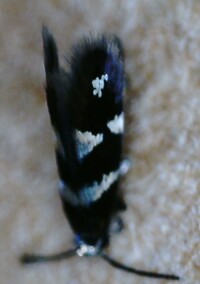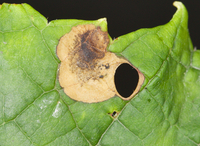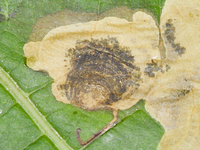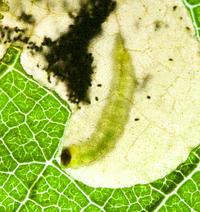Identification
Field Guide Descriptions: Online Resources: MPG , BugGuide , iNaturalist , Google , BAMONA , GBIF , BOLD Technical Description, Adults: Nieukerken et al. (2012)Technical Description, Immature Stages: Nieukerken et al. (2012)
Adult Markings: This is a tiny dark brown to blackish moth with an anterior fascia, a pair of triangular marks at midwing, and a subterminal spot. The following following description is from Nieukerken et al. (2012). Aspilanta in North America (A. viticordifoliella being the exception). Either barcoding or dissection of genitalia is needed to distinguish Antispila oinophylla from A.ampelopsifoliella , as well as a currently undescribed species. These three species are the only species with both a silvery white head and a sub-apical spot.
Wingspan: 5.5–6.2 mm for males; 4.8–5.6 mm for females (Nieukerken et al., 2012)Forewing Length: 2.5–2.8 mm for males; 2.3–2.8 mm for females (Nieukerken et al., 2012)
Adult Structural Features: Nieukerken et al. (2012) has detailed descriptions and illustrations of the male and female genitalia.
Adult ID Requirements: Identifiable only by close inspection of structural features or by DNA analysis.
Immatures and Development: The following description of the larval life history is from Nieukerken et al. (2012) and Nieukerken and Eiseman (2020). The eggs are laid singly and usually within 1–2 mm from a vein. The mine starts as a rather straight or slightly contorted linear mine towards the vein. It then usually forms a right angle and often follows the vein for a short distance, before turning away from the vein and expanding into a blotch. The linear portion of the mine is usually later incorporated into the blotch. The frass in the linear portion usually occupies the complete mine width, but is occasionally deposited in a thin line. In the blotch, much of the blackish-brown frass is deposited close to the origin in semi-circular concentric frass lines. These are best seen in thin shade leaves; in sun-exposed leaves the frass pattern is often obscured. The whole mine occupies as a rule an area of less than 10 × 10 mm; only in thin leaves are mines appreciably larger. The fully grown larva cuts out an elliptic case ca. 3.2–4.0 mm long. The larvae is yellowish green, with green gut contents, and a brown head and prothorax.

 »
»




 »
»


